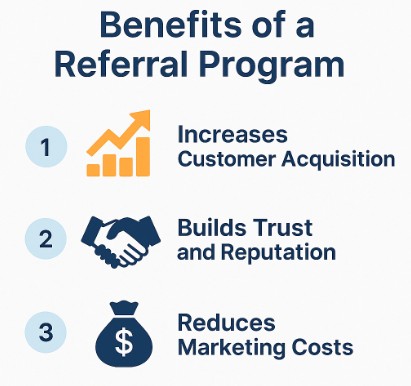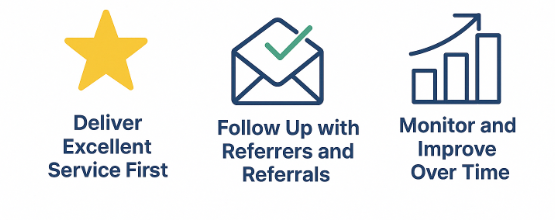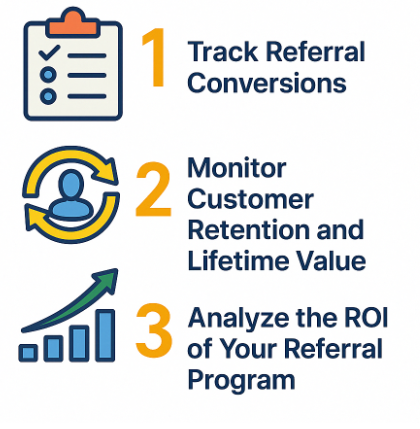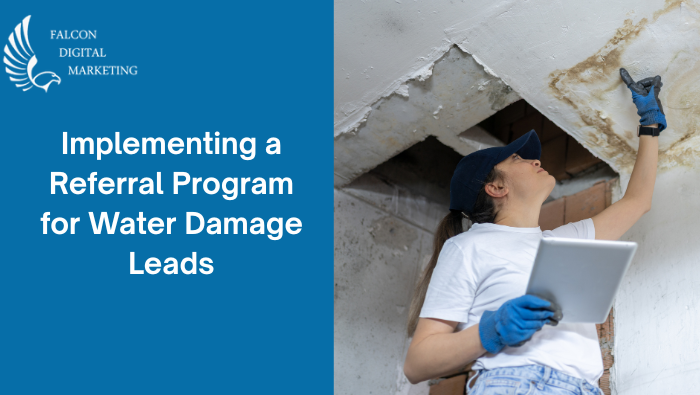Referral programs are one of the most cost-effective ways to generate new water damage leads. They use trust, not just advertising, to bring in clients who are more likely to convert. By encouraging your past clients and professional partners to recommend your services, you attract high-quality prospects who already believe in your service without relying on expensive ad spend.
If you’re in the water damage restoration industry, those relationships are some of your best assets. A good referral system helps you turn them into a steady stream of new business.
Let’s break down how referral programs work, why they matter, and how you can build one that supports long-term growth.
What Is a Referral Program for Water Damage Leads?
A referral program is a structured way to reward people who send you new customers. That includes homeowners, property managers, real estate agents, plumbers, or even insurance adjusters.
In water damage restoration, timing and trust matter. When someone refers your business, they’re vouching for your work. That credibility can make a big difference during stressful situations like floods, pipe bursts, or sewage backups.
A referral program helps you:
- Encourage more word-of-mouth marketing
- Build brand loyalty
- Generate warm, high-converting water damage leads
You can run it manually, through your Customer Relationship Management (CRM), or as part of a broader digital marketing strategy.
Why Set Up a Referral Program for Water Damage Leads?
You might be spending money on Google Ads, SEO, and email. But referral traffic often brings in some of your best leads.
Why? Because people trust people.
When a friend says, “These guys fixed our water damage fast and handled the insurance paperwork,” that’s better than any ad. Referral leads usually skip the comparison shopping. They’re ready to act.

Here’s what a strong referral program brings to your business:
1. Increases Customer Acquisition
You don’t need a massive budget to grow your customer base. You need your happy clients talking about you.
Referral programs take what’s already working, your service, and amplify it. People who’ve used your services know how fast you respond, how clean your team works, and how you handle stressful situations. Their recommendation carries real weight.
Here’s how you can drive more referrals:
- Offer something valuable to both the referrer and the new client
- Ask at the right moment, like after a job is completed successfully
- Promote your referral program through email, social, and follow-up calls
- Make the process simple: just a name, phone number, or referral link
If you already have repeat clients, turning them into referrers should be your next step.
2. Builds Trust and Reputation
Restoration services are high-trust purchases. People aren’t just looking for a service, they’re looking for peace of mind.
Referral programs help you build that trust before you even talk to a new client. The person referring you has already done the hard work of vouching for you.
This trust translates into:
- Fewer price objections
- Shorter sales cycles
- Better client relationships
You can also repurpose those referrals as testimonials, case studies, or social proof on your website.
3. Reduces Marketing Costs
Referral programs are one of the few strategies that lower acquisition costs as you scale. The more happy clients you serve, the more referrals you can generate.
You spend less on paid ads and still get quality traffic.
Compare this to traditional methods:

Referral leads often convert faster and stick around longer. You save on ad spend while building a strong base of loyal clients.
How to Create a Successful Referral Program for Water Damage Leads
Referral programs work best when they’re simple, trackable, and built around your customers’ needs. If you want to get more water damage leads without raising your ad budget, building a referral system is one of the most practical ways to do it.
Let’s walk through how to set one up that actually brings in results.
1. Define Your Target Audience
Start by identifying who you want your referrals to reach.
In the water damage industry, timing and location matter just as much as demographics. That means you need to know:
- Who is most likely to refer your business?
- Who are your best customers, and what do they care about?
- Which areas get hit hardest by flooding, burst pipes, or seasonal rain?
For example, property managers in flood-prone neighborhoods might be more responsive than homeowners in drier suburbs. Understanding that helps you focus your outreach.
Look at past jobs. Where did your best leads come from? Use that data to shape your targeting.
2. Choose the Right Incentives
Your incentive should match your service value and your audience’s expectations.
Incentives don’t need to be huge. They just need to feel fair and worth someone’s time. You’re not buying a review, you’re thanking someone for sending a serious lead your way.
Here are some examples:
- Referrers: Cash bonuses, gift cards, or a free inspection for every successful referral
- Referrals: A discount on their first service or a free moisture check during the visit
You can also tier the rewards.
For instance, offer $25 for the first referral, $50 for the second, and $100 for the third. That kind of structure encourages repeat participation and keeps people engaged.
3. Create a Referral Tracking System
If you can’t track it, you can’t grow it.
Referral programs fall apart when leads get lost or referrers don’t feel recognized. Use tools that keep the process organized.
That could be:
- A CRM like Jobber or ServiceTitan with built-in referral tracking
- A simple form on your website to submit names
- An email or phone tag system that links each lead back to the source
Make it easy to follow up, log the lead, and reward the person who referred them. Consistency builds trust and keeps the system running smoothly.
4. Promote Your Program Consistently
Even the best referral program won’t work if people don’t know it exists.
Build promotion into your regular communication. That includes:
- Mentioning the program after every job
- Including it in your email signature
- Posting about it monthly on social media
- Sharing it at networking events or with insurance contacts
If you’re active in your community, referrals become part of the conversation. Over time, this word-of-mouth awareness will help your program grow on its own.
Best Practices for Running a Referral Program for Water Damage Leads

Once your program is live, the goal is to keep it running effectively.
Here’s what to focus on:
Deliver Excellent Service First
Referral programs only work if your service is worth talking about.
If a customer has a bad experience, they’re not going to refer you. On the other hand, if your team shows up fast, communicates well, and leaves the property spotless, that client is more likely to share their story.
Exceptional service drives repeat business and referrals. It also turns those referrals into strong leads that convert quickly.
Follow Up with Referrers and Referrals
You’ve got to close the loop.
Once a referral comes in, reach out fast. Let the referrer know their lead was received. Thank them. Then follow up with the new contact to start building trust.
Use multiple channels for follow-up:
- Email reminders
- Text messages
- Quick thank-you calls
Even a short message like “Thanks for referring us to your neighbor! We appreciate your support!” can go a long way.
Prompt, thoughtful communication keeps people invested in the program and encourages future referrals.
Monitor and Improve Over Time
Don’t set it and forget it.
Referral programs need regular tuning. Track what’s working, what isn’t, and what can be done better.
Here’s what to monitor:
- Referral-to-lead ratio: How many referrals turn into actual jobs?
- Acquisition cost: Is this cheaper than your PPC spend?
- Engagement rate: Are people using the referral system or ignoring it?
If you see drop-offs, survey participants. Ask what’s holding them back. Maybe the form is too long, or the reward doesn’t feel worth it.
Use that feedback to adjust. Change your incentive, shorten the process, or improve how you promote it. Every improvement adds up.
How to Measure the Success of Your Referral Program for Water Damage Leads
Once your referral system is live, tracking its performance is just as important as launching it. You need to know what’s working, what isn’t, and what adjustments will bring better results.

Let’s break down the key ways to measure success.
1. Track Referral Conversions
The most important question: Are your referrals turning into paying jobs?
Conversion tracking tells you how many leads from your referral program become actual customers. That data helps you gauge lead quality and find out which sources deliver the best results.
We recommend using:
- Google Analytics to monitor site behavior and conversions
- Your CRM to log referral sources and job outcomes
- Email tools to track who clicks, opens, and replies to referral outreach
Suppose you send 20 referral links, get 10 leads, and close 5 jobs. That’s a 50% conversion rate from lead to job, which is a strong signal your system is working.
Watch for trends. Are referrals from social posts converting better than those from your email list? Is a particular referrer bringing in top-tier clients? Use that insight to guide future promotion.
2. Monitor Customer Retention and Lifetime Value
A great referral doesn’t just lead to one job. It can lead to repeat business.
That’s why it’s smart to look beyond the first sale. Start tracking how long referred customers stay with your business and how much they spend over time.
Here’s how to get started:
- Measure repeat job frequency for referred clients
- Track upsells, add-ons, or seasonal service requests
- Calculate the lifetime value of a referred customer compared to an average one
Let’s say your average customer books $600 in services over 12 months. If your referrals are averaging $1,200 in the same time frame, you know you’re bringing in better leads.
Use that data to prioritize referral-driven campaigns.
3. Analyze the ROI of Your Referral Program
How much are you spending on your referral program and how much are you getting back?
You’ll want to look at the cost to run the program versus the revenue generated from referred leads.
Include these costs:
- Incentives or rewards
- Admin time or software subscriptions
- Marketing materials or landing pages
Compare that to:
- Revenue from referred jobs
- Customer lifetime value
- Referrals who go on to refer others
Here’s a basic example:
If you spend $500 in rewards and admin costs and bring in $3,000 in referral-driven jobs, your ROI is strong.
The more you measure this, the easier it is to adjust your program for long-term profit.
FAQ
Why should I consider a referral program for my water damage business?
Referral programs are low-cost and high-impact.
Instead of spending more on ads, you let your customers help do the marketing. This works especially well in home services where trust is key.
A solid referral program can help you:
- Bring in better leads
- Lower your marketing costs
- Strengthen relationships with current clients
If you’re already providing great service, a referral program makes it easier to turn that goodwill into new business.
How do I start a referral program for water damage leads?
Start simple.
- Identify your best customers
- Decide what incentive you want to offer
- Build a system to track who refers who
- Promote it through your follow-up emails, texts, or in-person visits
You can also use your CRM to manage the process and make it easier to track referrals. Make sure your website and emails are mobile-friendly so customers can take action quickly.
What types of rewards should I offer for referrals?
Choose rewards that feel valuable but make sense for your business.
Some options include:
- $25 to $50 off the next job
- A free inspection or maintenance check
- Entry into a quarterly prize drawing
- Cash gift cards or prepaid bonuses
You can also create levels, like giving more for multiple referrals. Just keep it clear and easy to understand.
What other benefits come from running a referral program?
It’s not just about getting new leads.
A good referral program also:
- Builds loyalty with past clients
- Gives you more reviews and testimonials
- Increases your visibility in Google searches and local listings
- Strengthens your brand through word of mouth
When people share your service, it reinforces your reputation. That helps you stay top of mind when they or someone they know needs water damage restoration.
Other Articles You Might Also Be Interested In:

